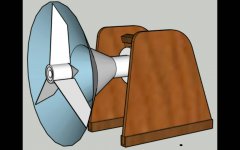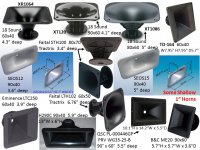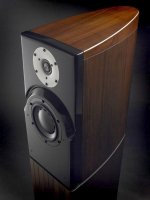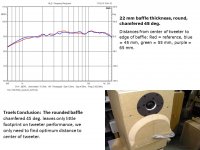Hi guys
I know there have been a few posts around time alignment but I'm still not clear on it. Its measured at the crossover point, yea?
From what I understand bass to mid alignment isn't really an issue, within reason.
Mid to HF yes its important. My tweeter is going to be mounted well behind the opening of my mid horn to get this alignment. Inline with the mid compression driver.
Can I use stepper or shallower crossover slopes to change the delay on one or the other driver?
Would really like to bring the tweeter forward relative to the mid driver. And no I don't want to use minidsp.....
Appreciate your thoughts.
I know there have been a few posts around time alignment but I'm still not clear on it. Its measured at the crossover point, yea?
From what I understand bass to mid alignment isn't really an issue, within reason.
Mid to HF yes its important. My tweeter is going to be mounted well behind the opening of my mid horn to get this alignment. Inline with the mid compression driver.
Can I use stepper or shallower crossover slopes to change the delay on one or the other driver?
Would really like to bring the tweeter forward relative to the mid driver. And no I don't want to use minidsp.....
Appreciate your thoughts.
You can delay the tweeter using cascaded all pass filters. I elected not to do this in my 3 way all active horn/Onken based system. So my tweeter is way behind the mid horn more or less as you describe.
I'm still getting everything to work correctly as the crossovers and amps are new. Lots of REW measurements will be necessary to sort it out.
Have a look at the schematic for an EV XEQ-3 (it's in the user manual) or similar if you want to see a viable implementation of allpass filters for this purpose.
I'm still getting everything to work correctly as the crossovers and amps are new. Lots of REW measurements will be necessary to sort it out.
Have a look at the schematic for an EV XEQ-3 (it's in the user manual) or similar if you want to see a viable implementation of allpass filters for this purpose.
Cool, thanks for this, was hoping that someone would have some idea's!
So I build the tweeter xover as per normal and then add band pass sections after that. As its for a tweeter would we add a band pass or another hi pass section? The hi pass would just have a lower xover point so not to add to the the xover section. Correct?
Any tables around to get a rough idea of the delay per section?
So I build the tweeter xover as per normal and then add band pass sections after that. As its for a tweeter would we add a band pass or another hi pass section? The hi pass would just have a lower xover point so not to add to the the xover section. Correct?
Any tables around to get a rough idea of the delay per section?
Nz,
I think there's a little confusion. Through the crossover region you need to have correct phase alignment. Adding or removing poles advances or retards the phase only within the frequency range at which the filter is effective. Getting this right is why you may see assymetrical filters (3rd order high, 2nd order low), especially in 2-way systems, and this may also force you to invert one or the other driver.
Builting a time-coincident system like Thiel or Vandersteen is another matter. That is where you may want to use an all pass to retard the tweeter so it is farther away, but this messes up your crossover alignment...
My point is, I think you just want correct phase alignment through the crossover section so the tweeter and midrange sum correctly. If you want to build a time-coincident system that's a lot more complicated and puts severe restrictions on the drivers and crossovers allowed.
Best,
E
I think there's a little confusion. Through the crossover region you need to have correct phase alignment. Adding or removing poles advances or retards the phase only within the frequency range at which the filter is effective. Getting this right is why you may see assymetrical filters (3rd order high, 2nd order low), especially in 2-way systems, and this may also force you to invert one or the other driver.
Builting a time-coincident system like Thiel or Vandersteen is another matter. That is where you may want to use an all pass to retard the tweeter so it is farther away, but this messes up your crossover alignment...
My point is, I think you just want correct phase alignment through the crossover section so the tweeter and midrange sum correctly. If you want to build a time-coincident system that's a lot more complicated and puts severe restrictions on the drivers and crossovers allowed.
Best,
E
Last edited:
Thanks E
Phase is always something I struggle with, understand the theory but can relate this to my measurements.
When I measure phase its always a saw tooth, then I convert it to minimal phase in REW and it always looks resonable. How do we get good phase measurements?
Clearly I'll have to do some more study on this....
Phase is always something I struggle with, understand the theory but can relate this to my measurements.
When I measure phase its always a saw tooth, then I convert it to minimal phase in REW and it always looks resonable. How do we get good phase measurements?
Clearly I'll have to do some more study on this....
can of worms:
Phase, Time and Distortion in Loudspeakers
I find that on a flat baffle it's enough to make the tweeter xover one order higher than the mid (Troels option #1)
Phase, Time and Distortion in Loudspeakers
I find that on a flat baffle it's enough to make the tweeter xover one order higher than the mid (Troels option #1)
NZ:
Here, I put up a complete 2-way system specifically to help you.
A Speaker Maker's Journey: The LM-1 Bookshelf Version
You can find the simulation files and a pointer back here to DIYAudio to a discussion area. Why don't you grab that, and examine how the phase changes as you add filters, or play with the woofer offset. It may help you understand alignment better.
It may help you understand alignment better. 
In the LM-1 I got fortunate in using symmetrical 2nd order filters without having to invert the tweeter.
Best,
Erik
Here, I put up a complete 2-way system specifically to help you.
A Speaker Maker's Journey: The LM-1 Bookshelf Version
You can find the simulation files and a pointer back here to DIYAudio to a discussion area. Why don't you grab that, and examine how the phase changes as you add filters, or play with the woofer offset.
In the LM-1 I got fortunate in using symmetrical 2nd order filters without having to invert the tweeter.
Best,
Erik
Thanks for the info guys, some really reading!
I think I'll have to read these a few times for it to sink in, lots of detail.
So to get things clear in my head, when I take a REW sweep should I be generating a minimum phase to review? Or look at the original sweep and examine whats happening at the xover point? Does it matter whats happening beyond the xover point, within reason?
Ok, I'll do some more reading and have a look at some of my saved REW sweeps and see if I can interpret these better.
I also have XSim so will have a play with that and see what happens to phase.
Once again, thanks - really appreciate your help.
I think I'll have to read these a few times for it to sink in, lots of detail.
So to get things clear in my head, when I take a REW sweep should I be generating a minimum phase to review? Or look at the original sweep and examine whats happening at the xover point? Does it matter whats happening beyond the xover point, within reason?
Ok, I'll do some more reading and have a look at some of my saved REW sweeps and see if I can interpret these better.
I also have XSim so will have a play with that and see what happens to phase.
Once again, thanks - really appreciate your help.
How do we get good phase measurements?
Trash single channel measurements and changeover to semi-dual channel measurement gear and mode. You will get correct timing and phase differences between the drivers without special tricks. That method will also support summing of off-axis measurements which is needed for more advanced speaker simulation in 3D, producing power responses and directivity index.
Gear, measurement method and settings is represented for example here: Preparation of response measurements for crossover simulation with VituixCAD
Minimum phase is purely based on amplitude response information. It does not include the phase shift caused by delay due to a physical offset. Unless all drivers have their acoustic centers at the same distance from the microphone, you need the full ( = minimum + excess) phase.So to get things clear in my head, when I take a REW sweep should I be generating a minimum phase to review? Or look at the original sweep and examine whats happening at the xover point? Does it matter whats happening beyond the xover point, within reason?
Be careful while measuring that you do not capture reflections or that you gate them out, as reflections alter both the amplitude and phase response.
Yes, you can.Can I use stepper or shallower crossover slopes to change the delay on one or the other driver?
I can appreciate that from an acoustic point of view.Would really like to bring the tweeter forward relative to the mid driver.
I don't understand your point here.use an all pass to retard the tweeter so it is farther away, but this messes up your crossover alignment...
This is why I'm asking the question.....
I want to mount my bullet tweeter in my mid range horn, but don't want to use minidsp, I want to keep it passive.
View attachment 692133
Don't worry about it.
Phase matching / time alignment is important at mid-high frequencies (say, up to 4-5kHz), but it becomes irrelevant (undetectable) at typical horn super-tweeter frequencies (>6kHz).
Don't worry about it.
Phase matching / time alignment is important at mid-high frequencies (up to 4-5kHz maximum), but it becomes irrelevant (undetectable) at typical horn super-tweeter frequencies (>6kHz).
This video explains the physiological process at play:
YouTube
Also: Greg Timbers weighs in on supertweeter alignment
Greg Timbers (formerly chief design engineer at JBL) had the following to say about this matter, when referring to the JBL K2 S9800 loudspeaker (the "045be" is the supertweeter, and the "435Be" is the compression driver):
"The comb filter effect is normal and cannot be eliminated, even with the use of electronic delay. The wavelength at 10k is an inch or less and even if the 045be were delayed to the z plane of the 435Be, even the slightest movement up, down, left or right of the measurement position would change the relative path length between the 435Be and 045Be to where the interference pattern would return.
What I have done is use a 4th order on the 045Be high pass and adjusted the values using substantial smoothing on the frequency response curve. The polarity does seem to matter in getting the smoothest "smoothed" curve.
I originally had the 045Be coming in where the main 435Be cuts off (15k) which cost less parts, but we could hear the 045Be as a separate location and it was distracting. I found that 8k - 10k minimized this effect. In spite of the curve, we have had no negative comments about the 045Be and the choppy response through the crossover range."
(from: AUGUST 2004)
Greg Timbers (formerly chief design engineer at JBL) had the following to say about this matter, when referring to the JBL K2 S9800 loudspeaker (the "045be" is the supertweeter, and the "435Be" is the compression driver):
"The comb filter effect is normal and cannot be eliminated, even with the use of electronic delay. The wavelength at 10k is an inch or less and even if the 045be were delayed to the z plane of the 435Be, even the slightest movement up, down, left or right of the measurement position would change the relative path length between the 435Be and 045Be to where the interference pattern would return.
What I have done is use a 4th order on the 045Be high pass and adjusted the values using substantial smoothing on the frequency response curve. The polarity does seem to matter in getting the smoothest "smoothed" curve.
I originally had the 045Be coming in where the main 435Be cuts off (15k) which cost less parts, but we could hear the 045Be as a separate location and it was distracting. I found that 8k - 10k minimized this effect. In spite of the curve, we have had no negative comments about the 045Be and the choppy response through the crossover range."
(from: AUGUST 2004)
You can obtain both controlled directivity plus time alignment with a well designed horn speaker.
There are a few shallow horns/waveguides which can time align with the voice coil on a modest diameter woofer. The 3.6" deep SEOS12 waveguide offers close time alignment with a few 10" - 12" midwoofers like the 4.9" deep Eminence Delta Pro 12A. The massive EconoWave threads will provide education and proven design options.
=====
With a standard dome tweeter, a properly constructed stepped baffle for time alignment has become popular.
There are a few shallow horns/waveguides which can time align with the voice coil on a modest diameter woofer. The 3.6" deep SEOS12 waveguide offers close time alignment with a few 10" - 12" midwoofers like the 4.9" deep Eminence Delta Pro 12A. The massive EconoWave threads will provide education and proven design options.
=====
With a standard dome tweeter, a properly constructed stepped baffle for time alignment has become popular.
Attachments
- Status
- This old topic is closed. If you want to reopen this topic, contact a moderator using the "Report Post" button.
- Home
- Loudspeakers
- Multi-Way
- Driver time alignment



